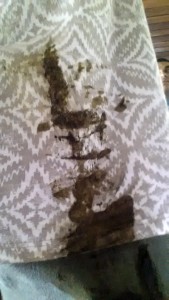Today we toured the organic farm and animal husbandry area of Earth University. The farming is done organically without special inputs and chemicals. The crops are highly diverse, with a variety of vegetables grown right next to each other. Wastewater was processed through a series of ponds which used natural plant life to remove impurities.
The animal husbandry was inspiring. I have never seen such happy animals in such natural settings. The chickens had dirt to scratch in, plenty of bugs to eat, and nest boxes to lay eggs in. They walked right up to us very curious who we were and why we were there. They also had an adjoining yard to wander around in.
The pigs had lots of mud to root around in. The pregnant sows had a large muddy enclosure and didn’t fight, as you so often hear they do in American agriculture. The moms and babies each got their own enclosure – no farrowing crates. They all kept their tails and teeth. They all also had a large grassy area with little wooden houses. Our guide Mario explained that these pigs have no stress in their lives – they are living as nature intended pigs to live. So there is no problem with the piglets chewing each other’s tails or the moms sitting on the babies. He also said the meat tastes much better this way.
Earth University grows all its own food, including any meat that is served in the cafeteria. The fruits and vegetables and totally fresh, and everything is healthy. Can this be done on a large scale? Not a large monocrop farm. But the UN has a recent report saying small scale agriculture is what will feed the world. This kind of agro-ecology is exactly what we saw today at Earth University. Developing countries like Costa Rica don’t need to be importing agriculture inputs including expensive chemicals from us. They can grow their own and feed themselves.
In turn, we could be localizing more of our own food, growing it smaller scale, and providing more jobs. So many rural towns are decimated by having no jobs, but if farming employed more people again, these towns could come back to life. We may not be able to do away with chemicals altogether, but we could cut back a lot, and also cut use of antibiotics to give them only when an animal is actually sick, not in low doses to prevent illness because they are so crowded together. 80% of antibiotics are currently used on farm animals, and they are losing their effectiveness for humans.
Would these practices raise the cost of food? Yes, but by how much? A little more is worth it to gain all these advantages over the current system. Even 1.5 times as much that Mario mentioned is worth it. You can pay for the food now or the doctor later. Everything works better if you pay the costs now – it’s better for the land, the animals, and human health. Americans pay a smaller percentage of their income for food than people in any other country — under 6 percent. We can afford to pay a little more to treat the land and animals more sustainably and humanely.
I wasn’t sure what peri-urban agriculture was before this trip, so I looked it up. It is basically agriculture in semi-urban settings such as suburbs, vacant lots, and the like. The peri-urban agriculture we saw at Earth University was all about vegetables and grew food in a number of different ways. Sometimes it was in raised beds, with crops such as lettuce planted in a mixture of rice hulls, charcoal bits and coconut shells. Sometimes it was grown in small gardens bounded by old soda bottles, bike tires, or even on an old bicycle.
Another area had plants growing out of holes cut into long plastic bags or old jeans legs and stacked lattice style to save room in an ad hoc greenhouse made from bamboo poles covered in plastic. Another area had them planted in whatever container was available such as an old bucket, hanging tire, or soda bottle hanging from a window. We ended the tour by making our own planters out of soda bottles, and painting them with our own designs.
This tour gave me a lot of ideas for how I could grow my own food at home even though I live in a detached condo with a postage-stamp sized yard. We have no room for a vegetable garden like the one I grew up with, but anyone could use the techniques modeled here to grow food in any size space. Ron Finley, a food activist in Los Angeles, says growing your own food is like printing money. That’s something we can all do.







